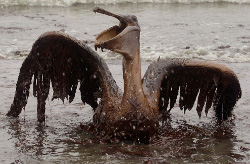
Gulf oil spill: the aftermath By MERLIN FLOWER for OIL-PRICE.NET, 2010/06/07
...Corexit is an extremely toxic chemical dispersant. It was favored by BP over other alternative dispersants more ecologically friendly and with a better track record, mostly for cost reasons. It is estimated that more than 870,000 gallons (3.2 million litres) of Corexit has been used so far, either sprayed on the surface or released underwater-150,000 gallons (570,000 litres).
...Corexit is an extremely toxic chemical dispersant. It was favored by BP over other alternative dispersants more ecologically friendly and with a better track record, mostly for cost reasons. It is estimated that more than 870,000 gallons (3.2 million litres) of Corexit has been used so far, either sprayed on the surface or released underwater-150,000 gallons (570,000 litres).
Dispersants rely on wave movements shearing the oil film mechanically in order to refine crude oil into separate chemicals. This may have worked to some extent on the Exxon Valdez spill of Alaska where waves are big but in the Gulf of Mexico? Ever heard of a surfing competition in the gulf? The waves are just not there for the dispersant to work.
Seven cleanup workers were hospitalized last week after complaints of headache, dizziness, breathing problems and nausea. The workers are said to have told the doctors, according to the medical centre sources, that the chemical dispersant used to break up oil had made them sick. Doctors believe the likely cause to be chemical irritation as well as dehydration from working in the heat.
Manufactured by Nalco Energy Services L.P., the Material Safety Data Sheets state that Corexit 9500 cause irritation when in contact with skin, chemical pneumonia if ingested and irritation to the respiratory tract with repeated and prolonged inhalation. MSD of Corexit EC 9527A states: Symptoms of Exposure - Acute : Excessive exposure may cause central nervous system effects, nausea, vomiting, aesthetic or narcotic effects. - Chronic : Repeated or excessive exposure to butoxyethanol may cause injury to red blood cells (hemolysis), kidney or the liver
....Know this: Most of the hydrocarbon chemicals extracted by the dispersants stay at the surface. They are the first ones to evaporate alongside water into clouds overhead that later fly over the continent and provide rain to the southern states. We are talking about chemicals causing cancer or kidney failure such as benzene and pretty much any possible chemical that can be extracted from crude oil. These chemicals would end up in water supplies, rain on crops, and eventually imbibed by humans and animals alike.
The 2010 Atlantic hurricane season began on June 1 and The National Oceanic and Atmospheric Administration (NOAA) predicts 8-14 hurricanes ,14-23 storms, and 3-7 major hurricanes-the figures higher than normal years.
During the next few hurricanes, extreme shearing at the surface of the sea will boost the chemical action of dispersants which separate petroleum chemicals and suddenly increase the concentration of noxious chemicals evaporating from the spill. These hurricanes will carry this noxious cocktail across the southern US and north of Mexico, polluting the water supply and all that depend on it.
There's a big similarity between what is bound to happen and the aftermath of Chernobyl. After the Chernobyl catastrophe a radioactive cloud hovered over Western Europe and it has been recorded that many forms of cancer went much higher than usual. This was never formerly acknowledged by local governments.
Seven cleanup workers were hospitalized last week after complaints of headache, dizziness, breathing problems and nausea. The workers are said to have told the doctors, according to the medical centre sources, that the chemical dispersant used to break up oil had made them sick. Doctors believe the likely cause to be chemical irritation as well as dehydration from working in the heat.
Manufactured by Nalco Energy Services L.P., the Material Safety Data Sheets state that Corexit 9500 cause irritation when in contact with skin, chemical pneumonia if ingested and irritation to the respiratory tract with repeated and prolonged inhalation. MSD of Corexit EC 9527A states: Symptoms of Exposure - Acute : Excessive exposure may cause central nervous system effects, nausea, vomiting, aesthetic or narcotic effects. - Chronic : Repeated or excessive exposure to butoxyethanol may cause injury to red blood cells (hemolysis), kidney or the liver
....Know this: Most of the hydrocarbon chemicals extracted by the dispersants stay at the surface. They are the first ones to evaporate alongside water into clouds overhead that later fly over the continent and provide rain to the southern states. We are talking about chemicals causing cancer or kidney failure such as benzene and pretty much any possible chemical that can be extracted from crude oil. These chemicals would end up in water supplies, rain on crops, and eventually imbibed by humans and animals alike.
The 2010 Atlantic hurricane season began on June 1 and The National Oceanic and Atmospheric Administration (NOAA) predicts 8-14 hurricanes ,14-23 storms, and 3-7 major hurricanes-the figures higher than normal years.
During the next few hurricanes, extreme shearing at the surface of the sea will boost the chemical action of dispersants which separate petroleum chemicals and suddenly increase the concentration of noxious chemicals evaporating from the spill. These hurricanes will carry this noxious cocktail across the southern US and north of Mexico, polluting the water supply and all that depend on it.
There's a big similarity between what is bound to happen and the aftermath of Chernobyl. After the Chernobyl catastrophe a radioactive cloud hovered over Western Europe and it has been recorded that many forms of cancer went much higher than usual. This was never formerly acknowledged by local governments.
See also: Gulf Oil Spill Health Hazards.










No comments:
Post a Comment
Note: Only a member of this blog may post a comment.